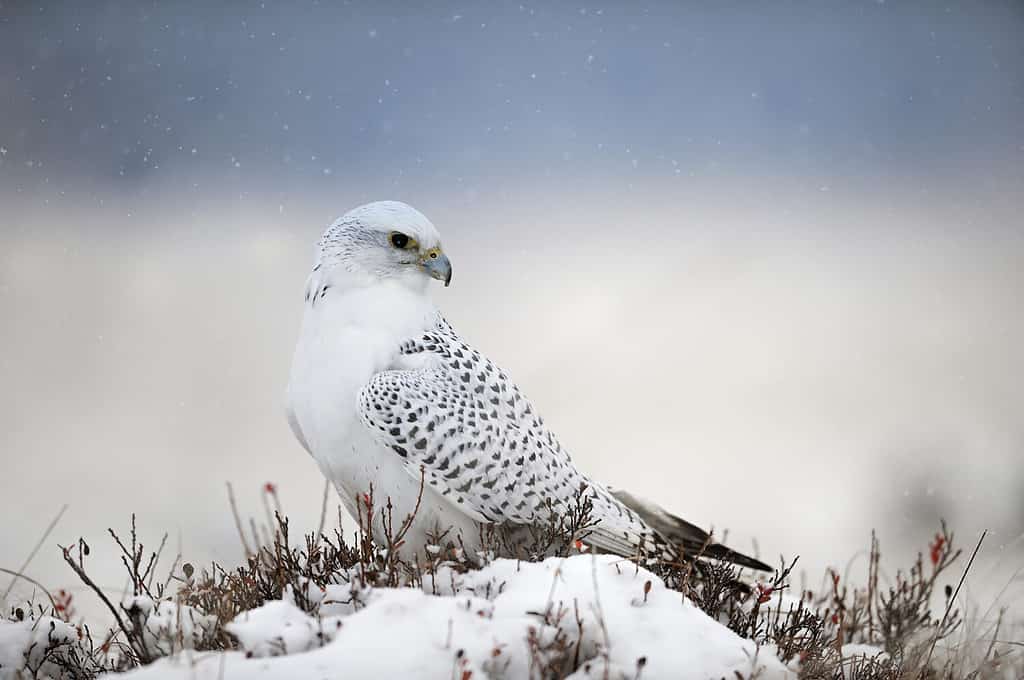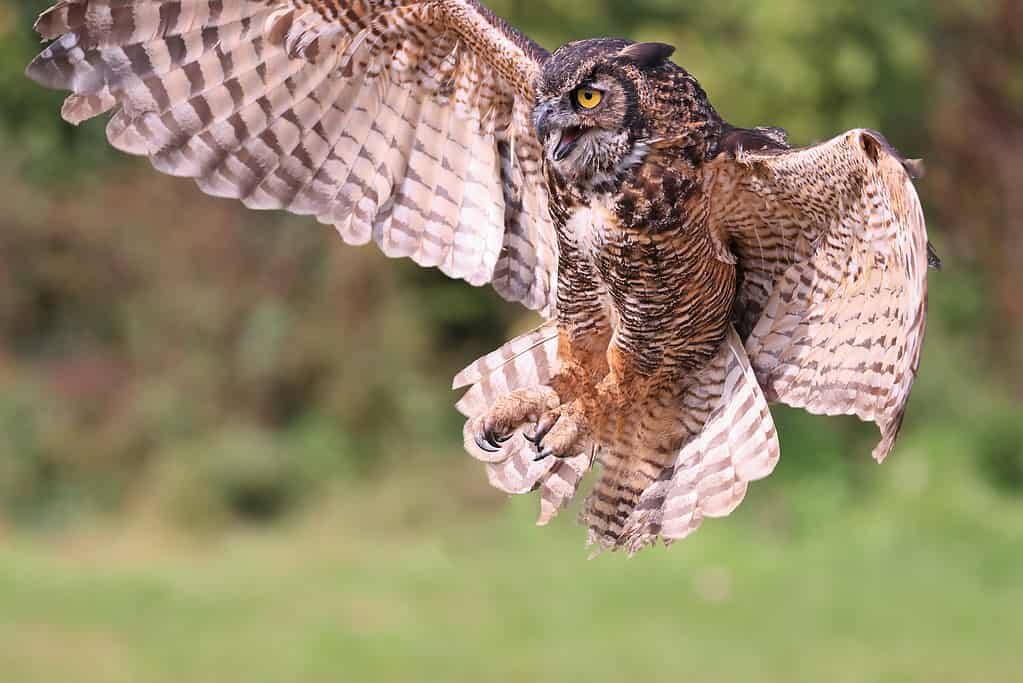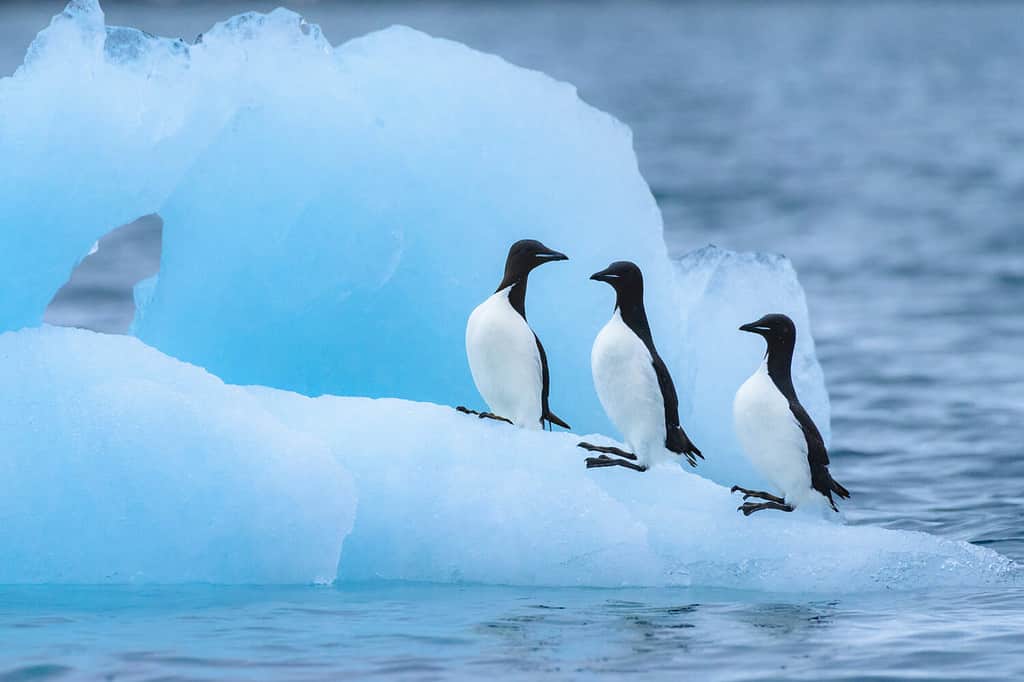As frost as the landscape may be, did you know that several species of birds spend their winters in Alaska? Continue reading below to learn about 7 of these species, including where in the state you may find them.
It’s important to note that this list focuses on species that are year-round residents in Alaska, not migratory species that winter in Alaska. With that in mind, let’s dive in!
1. Gyrfalcon

Gyrfalcons are magnificent raptors that spend their winters in Alaska.
©Michal Pesata/Shutterstock.com
The gyrfalcon (Falco rusticolus) is a year-round species throughout most of the state of Alaska. This excludes the southeastern coastal region, where they are a wintering species. These interesting falcons will breed in arctic and alpine regions during the summer, where prey and other resources are in greater abundance. During the winter months, they will settle at lower elevations in the north, where the frosty climate is more hospitable.
Ptarmigans make up a significant portion of the gyrfalcon’s diet. As a result, they are often found in close proximity to where these birds are. While the willow ptarmigan and rock ptarmigan make up the largest part of this falcon’s diet, they will eat other animals. This includes other birds, even other raptors such as hawks, owls, or falcons, or mammals such as young foxes. Unlike other raptors that capture prey in midair, the gyrfalcon has a much more aggressive approach, often attacking prey and diving it into the ground in order to secure the hunt. Most often, this results in a broken breastbone for the prey, making escape difficult, if not impossible.
2. Rock Ptarmigan

This bird’s brown feathers turn gray in the fall in preparation for an entirely white plumage.
©Tatiana Ivkovich/Shutterstock.com
Rock ptarmigans (Lagopus muta) are a year-round species throughout much of Alaska, excluding the central region of the state. Much of the area that they are not found aligns with the Yukon River.
During the breeding season, males sport a striking white coat. This coat also helps them stay camouflaged in the winter. However, as the snow melts, this dashing coat, while good at wooing potential mates, makes the rock ptarmigan an easy target for predators, such as the gyrfalcon. As a result, until they are able to molt into their darker summer plumage, the rock ptarmigan actually seeks to dirty up its feathers. This helps it better blend into the environments.
3. Willow Ptarmigan

Willow ptarmigans are the state bird of Alaska.
©Troutnut/Shutterstock.com
The willow ptarmigan (Lagopus lagopus) is another essential prey animal for the gyrfalcon, as well as a prime example of birds that spend their winters in Alaska. Unlike the rock ptarmigan, this species’ breeding coat is much better adapted to camouflage. This is because their breeding plumage leaves them sporting brown feathers on their head and neck, with white on the rest of the body. Their winter plumage is entirely white.
Willow ptarmigans have a larger range than the rock ptarmigan, but they, too, avoid the the central region of the state.
4. Boreal Chickadee

The boreal chickadee is a small songbird found in much of Alaska.
©Matthew Jolley/ via Getty Images
Raptors and game birds aren’t the only types of birds that spend their winters in Alaska, though.
The boreal chickadee (Poecile hudsonicus) is a common passerine species in the state. They live throughout much of the region, excluding coastal areas. Outside of Alaska, seeing this species in the United States can be extremely difficult. This is because they are an entirely year-round resident in North America. However, they prefer to settle in the northern areas of the continent, like Canada. However, you may be looking to catch a glimpse of this species in the northernmost areas of certain states like Montana and Maine.
5. Cassin’s Auklet

Cassin’s auklet can be found along the Alaskan peninsula year-round.
©Sabine’s Sunbird / CC BY-SA 3.0 – License
Some of the birds that spend their winters in Alaska can’t always be found inland.
Take Cassin’s auklet (Ptychoramphus aleuticus) for example. This species is a year-round resident in Alaska. However, they can only be found in the southern coastal regions. This includes areas such as along the islands off the Alaskan peninsula and Kodiak Island. These gray little seabirds can be best identified by the small white marking above their eye.
6. Great Horned Owl

Great horned owls are magnificent raptors found throughout most of the United States, including Alaska.
©Vladone/iStock via Getty Images
The great horned owl (Bubo virginianus) is a staple species throughout the United States. This includes Alaska, where they are found almost everywhere, excluding eastern coastal regions and the northern part of the state. They are one of the most common species of owls in North America. These owls inhabit a variety of different types of forests. They are named for their tufts, which resemble horns.
7. Thick-Billed Murre

Thick-billed murres are seabirds not found in the inland areas of Alaska.
©Danita Delimont/Shutterstock.com
The thick-billed murre (Uria lomvia) is one of the rarer year-round residents of Alaska. This is because this species, while being found here in the winter, has no inland habitats. Instead, seabirds, they inhabit both the coastal and open ocean waters surrounding the state. They can be found off every coast of Alaska except for the northern coastline.
The photo featured at the top of this post is © iStock.com/slowmotiongli
Thank you for reading! Have some feedback for us? Contact the AZ Animals editorial team.






